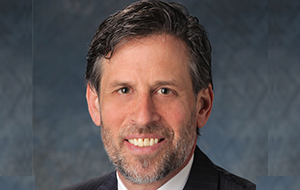Technology is becoming a bigger component of the products most enterprises sell — and that means CIO roles must combine with R&D and product development. That's the viewpoint of Stuart Sackman, corporate vice president, global product and technology at human capital management (HCM) provider ADP. In this interview with The Enterprisers Project, he explains how this has worked in his own career.

The Enterprisers Project (TEP): How has the role of the CIO changed in recent times?
 Sackman: The CIO role is expanding to encompass oversight of not only internal IT strategy and enterprise processes, but also of the R&D/product development function for clients. Technology is at the center of both functions and as a result, they are significantly intertwined. This convergence has organically evolved the CIO role.
Sackman: The CIO role is expanding to encompass oversight of not only internal IT strategy and enterprise processes, but also of the R&D/product development function for clients. Technology is at the center of both functions and as a result, they are significantly intertwined. This convergence has organically evolved the CIO role.
TEP: You, yourself hold the title corporate vice president, global product and technology, replacing a role which formerly had the title CIO. Do your (relatively) new responsibilities and title reflect how the role is changing?
Sackman: Yes, absolutely. Overseeing both internal IT processes and external technology product development makes strategic sense. There is great value in having projects seen from start to finish under the same strategy and leadership, especially at ADP where workforce management technology is the heart of our business. We are able to develop solutions in our Innovation Lab and even test them internally prior to releasing them on the market.
TEP: Your education and experience is mostly in business management. Can you tell us about the challenges — and benefits — of having someone with more of a business than tech background in charge of ADP's software products?
Sackman: My experiences running several businesses at ADP, and prior to that doing strategy consulting for large technology companies, has given me deep insights into the needs of our clients and the challenges they face using today's HCM solutions. My knowledge of our clients' needs is a tremendous advantage as we design and build ADP's SaaS products. I'm also a bit of a technology geek, so I have stayed abreast of the overall trends in technology through reading, conferences, and using all the latest apps.
TEP: How do you manage technological decisions without a deep technology background?
Sackman: I have a group of trusted advisors that include people that work for me and outside experts that I count on for help. When I'm faced with a technical decision I triangulate the answer by talking separately to my internal trusted advisors, external advisors, and vendors. Often a consensus emerges that makes me confident in my final decision. I also do a lot of skip-level meetings. I find that by talking to people further down in the organization, the people building our solutions and solving technical problems every day, I learn a lot and that helps me make better decisions.
TEP: How is technology changing ADP as a workplace?
Sackman: Technology is both driving and enabling the changing nature of work. With the proliferation of new consumer technology, employees are changing their expectations of how they interact with their employers. Employers need to remain competitive through the use of human capital management technologies to improve the employee experience and allow work to fit into the way they naturally live their lives.
For example, with the increase in mobile and remote workers, we're seeing a huge uptick in usage of our mobile solution. It has attracted 6 million users since its launch and 1 million in the past 6 months alone. In the near future, we expect solutions to be developed for mobile first, and then adapted for desktop use.
We've also devoted effort recently to shift our user experience from the current "pull" model, requiring users to log in to systems to obtain information, towards more of a "push" model, where we apply machine learning to understand the users and share highly personalized information related to the tasks they are performing. We want our solutions to behave like an intelligent personal assistant for our users, helping them manage their work lives and perform basic tasks automatically on the users' behalf.
TEP: What advice would you offer CIOs about managing their evolving roles?
Sackman: Take the time to understand, at a detailed level, how your products work. Commit to spending time every month with your internal and external clients to understand their current challenges and evolving needs. And as you use disruptive new technologies and services outside of work, think about how the principles of those solutions can be applied within your product portfolio. For example one of my favorite features of Uber is that I have 100 percent real-time visibility into the location of my driver. At ADP we still deliver a lot of paychecks and reports to our clients. Based on my experience with Uber I'm challenging my teams to provide the same visibility into the location of our packages.







